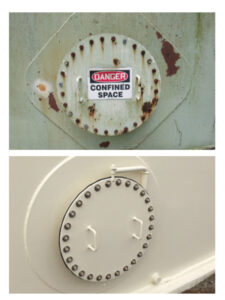Imagine A Day Without Water
There are many reasons why a community may find itself without potable water. Natural disasters, such as ice storms, heavy rains, flooding, drought, and other occurrences can temporarily cause issues with water distribution. Many water departments plan for these events and, while sometimes devastating and unavoidable, the water contamination or shortage is brief. Infrastructure issues are another reason that a community may find itself without clean water. The recent water crisis in Jackson, Mississippi has been a constant topic of conversation for our water and wastewater team. We recognize that what led to Jackson’s water crisis is a combination of issues, and in hindsight the situation could have been lessened or prevented with adequate maintenance, planning for growth, and redundancy.
Maintenance
 Maintenance for a utility district takes many different forms but one of the most troublesome, yet often overlooked enemies of the water industry is corrosion.
Maintenance for a utility district takes many different forms but one of the most troublesome, yet often overlooked enemies of the water industry is corrosion.
Owners and facility managers too often forgo the cost implications of corrosion as it may not be an issue that requires immediate attention. A utility district’s largest and most visible asset is a welded steel storage tank. These tanks serve as billboards for a water system and its surrounding community. A well-maintained and aesthetically pleasing water tank can have a positive impact, giving the community an increased level of confidence in the water service provider and an overall comfort in the water they are drinking.
Protecting these assets against corrosion can be achieved using coating systems on steel tanks. Application and qualified oversight of the correct coating systems can help owners reduce long-term costs while keeping assets looking and performing at their peak for years to come.
Planning
We have been involved in updating the City of Brentwood’s water system master plan since 2009. The plan accommodates for both residential and commercial growth in the system and anticipates future growth.
Regularly, the plan is updated based on evaluations of existing infrastructure within the system and identifies potential water sources and improvements to reduce operational cost. The latest update with the City included water-use projections and prioritized improvement recommendations within the distribution system. These projections were based on comprehensive water system analyses, compiled through modeling updates and discussions with water services staff and planning officials.
The master plan allows the City to make informed and financially responsible infrastructure decisions that will impact the residents and commercial property owners for years to come.
Redundancy
The City of Clarksville is experiencing rapid growth and in 2018 expedited the design and construction of a new water treatment plant to ensure they had the resources to meet the community’s growing water demand.
Instead of expanding or replacing the existing facility, city officials decided to build a second plant that allows for a redundancy if something were to happen to either of the plants. Having redundant plants allows for the City to have a backup in event of natural disaster, water breaks, maintenance outages, etc.
The new North Clarksville Water Treatment Plant project has also been designed to grow with the community. When it opens in 2024, the plant will have a capacity of 12MGD with room to expand to 36MGD to provide water for the industrial, commercial, and residential customers of Clarksville for decades to come.
By prioritizing and investing in maintenance, planning, and redundancy now, you can help ensure that you will only need to imagine instead of experience a day without water in the future.







